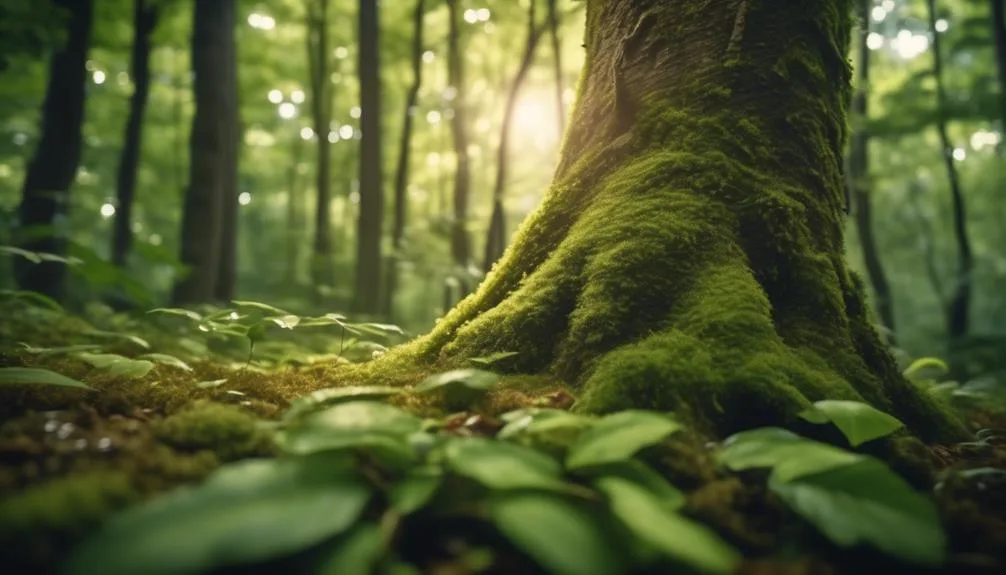Beech trees play a crucial role in supporting a diverse range of plant and animal life in forest ecosystems. Their tall canopies and extensive root systems create a thriving habitat for many species.
From the activity in the treetops to the life below the forest floor, beech trees significantly influence the biodiversity of their surroundings.
Exploring how these majestic trees sustain life reveals their fascinating impact on the ecosystems they inhabit.
Beech Trees as Habitat Providers
Beech trees provide vital habitat for a diverse array of species, supporting an intricate web of life within their branches, foliage, and roots. These majestic trees create microhabitats that are essential for the survival of various organisms within the forest ecosystem.
The nooks and crannies of their bark provide shelter for insects, while their leaves offer food and nesting sites for birds and small mammals. Additionally, the fallen leaves and decaying wood of beech trees contribute to the forest floor's rich biodiversity by providing nutrients for fungi, insects, and other decomposers.
The presence of beech trees also influences forest ecosystem dynamics, as their shade-tolerant nature affects the growth of understory plants and the distribution of different animal species. Overall, the intricate microhabitats that beech trees create play a crucial role in sustaining the biodiversity of forest ecosystems.
Biodiversity Support Through Beech Tree Canopy
Supporting an intricate web of life within the forest ecosystem, the canopy of beech trees plays a crucial role in sustaining biodiversity by providing vital habitat for a diverse array of species.
This lush, green canopy provides a haven for various flora and fauna, fostering a thriving ecosystem. The dense foliage of beech trees creates a shaded microclimate, offering refuge and sustenance to an array of organisms.
Canopy interactions facilitate the flourishing of epiphytic plants, insects, birds, and mammals, each contributing to the resilience of the ecosystem. The intricate network of branches and leaves forms a protective shield against harsh weather, creating a stable environment for life to thrive.
This canopy not only provides a home for numerous species but also plays a pivotal role in maintaining the overall health and balance of the forest ecosystem.
Understory and Soil Biodiversity in Beech Tree Ecosystems
Nurturing a rich and diverse ecosystem, the understory and soil beneath the majestic beech trees teem with a multitude of life forms, each contributing to the intricate web of biodiversity within this thriving ecosystem.
Understory diversity in beech tree ecosystems is a key component of their remarkable biodiversity. The shaded understory provides a habitat for a wide array of plant species, including delicate ferns, vibrant wildflowers, and diverse ground cover, creating a haven for various insects, small mammals, and birds.
Additionally, the soil beneath beech trees is crucial for maintaining soil health and supporting a complex network of fungal communities. These fungal networks, in symbiosis with the roots of beech trees, play a vital role in nutrient cycling, enhancing soil structure, and promoting the overall health of the ecosystem.
Together, the understory and soil of beech tree ecosystems contribute significantly to the rich biodiversity of these woodlands.
Beech Trees and Wildlife Corridors
While exploring the forested landscape, you'll encounter how beech trees serve as vital components of wildlife corridors, providing connectivity for various animal species to move through the ecosystem. Beech trees play a crucial role in facilitating wildlife movement and enhancing landscape connectivity.
- They provide shelter and nesting sites for birds, creating a safe passage for them to move through the forest.
- The nuts produced by beech trees are a vital food source for many mammals, supporting their survival and encouraging movement across the landscape.
- The dense foliage and interconnected root systems of beech trees offer protection and pathways for small mammals and insects, enabling them to traverse the terrain more easily.
- The presence of beech trees helps maintain a balanced ecosystem by promoting the movement of pollinators, which is essential for the reproduction of various plant species.
Role of Beech Trees in Supporting Insect Biodiversity
In the intricate world of forest ecosystems, beech trees play a vital role in fostering a rich and diverse community of insects, contributing to the overall biodiversity of the local environment. Beech trees provide essential support for insect biodiversity through various means, including serving as a vital source of food and habitat. This fosters a complex web of interactions that support the broader ecosystem. The table below illustrates the diverse range of insects that thrive in association with beech trees, highlighting their contribution to the local biodiversity and ecosystem dynamics.
| Insect Species | Role in Ecosystem |
|---|---|
| Bees | Pollination support |
| Beetles | Decomposition, nutrient cycling |
| Butterflies | Pollination, food for predators |
| Ants | Seed dispersal, pest control |
Beech trees, in essence, play a crucial role in shaping the intricate food web dynamics and pollination support, ultimately enhancing the overall biodiversity of the local environment.
Conclusion
In summary, beech trees are vital contributors to local biodiversity. They provide habitat for diverse species, support plant and animal life, and promote soil biodiversity. Understanding and protecting these trees is crucial for preserving the balance of our ecosystem.

My interest in trees started when I first saw the giant sequoias in Yosemite.
I was a teenager then, and I remember thinking, “I need to learn more about this.”
That moment stuck with me.
A few years later, I went on to study forestry at Michigan Tech.
Since graduating, I’ve worked in a mix of hands-on tree care and community education.
I’ve spent over ten years helping people understand how to plant, maintain, and protect the trees in their neighborhoods.
I don’t see trees as just part of the landscape.
They are living things that make a real difference in our daily lives.
